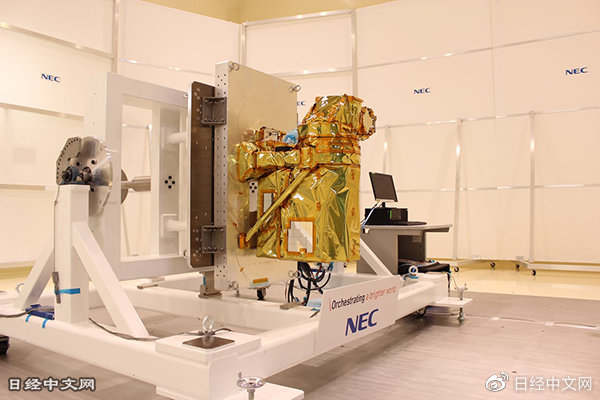If large-capacity optical communication is popularized in space, it is also expected to be used for new applications such as Internet connection and communication with moon bases.
Editor’s note: This article from the “Nikkei Chinese net”, the author: the big plus trees.
Japan Aerospace Exploration Agency (JAXA) will begin to use the system that uses light for communication between artificial satellites as early as 2021. The data transmission speed of optical communication is more than 7 times that of communication using electric waves in the past, which is close to the current high-speed communication standard 5G. If large-capacity optical communication is popularized in space, it is also expected to be used for new applications such as Internet connection and communication with moon bases.
Schematic diagram of using light to communicate in space (provided by JAXA)
In daily life, when using the Internet through smartphones and personal computers, the digital signal carrying information is generally converted into light, and the information is transmitted to the receiver through optical fiber cables. Light is the protagonist of terrestrial communication infrastructure.
On the other hand, radio waves are mostly used in space and the communication between space and the ground. Radio waves are not easily affected by the weather, are easy to transmit over long distances, and can send and receive data relatively easily.
The communication system “LUCAS” that JAXA will begin to use combines a geostationary satellite that is relatively stationary on the ground and two earth observation satellites that orbit the earth and photograph various situations. Install devices that mainly receive optical signals on synchronous satellites, and install devices that transmit light on earth observation satellites to exchange information.
When this system is adopted, the communication speed between satellites is 1.8GB per second, which is expected to be close to the current speed of 5G (2~4GB per second) for starting services on smartphones and the like. Transit through synchronous satellites to transmit back to the earth images of forests and fields taken by Earth observation satellites.
The geostationary satellite has been sent into space in November 2020 by the Japanese domestic rocket “H2A” Unit 43. JAXA and the Japan Institute of Information and Communication Research (NICT) have confirmed that the ground device that simulates the earth observation satellite and the synchronous satellite can receive and emit signals normally. The Earth observation satellite “Dadi 3” will be launched in 2021, and the LUCAS system will be used after several months of operation confirmation.
The reason why a synchronous satellite is used for transit is because the earth observation satellite can only transmit data to the ground for about 10 minutes in a 90-minute circle around the earth, and there is a time constraint. If you use a transit method, you canThe transmission period can reach about 4 times, and the time for real-time data transmission will be extended.
The characteristic of Dadi 3 is its high accuracy. Even if it is more than 600 kilometers above the ground, it can take pictures of the ground conditions at an interval of 80 cm. However, the data volume of high-resolution images is very large. If light with a transmission speed of more than 7 times the radio wave is used, it can transmit more than 7 times the data in the same time. Even if it takes high-resolution images of the natural environment and disaster-stricken areas in the event of a disaster, it can communicate smoothly and is expected to be used in rescue activities, agriculture, and fisheries.
The improvement of the performance of signal transceivers makes optical communication in space possible. The method of amplifying optical signals by setting up a relay on the way in submarine optical cables is very difficult in space. It is necessary to transmit an optical signal with a high output power that is more than 10 times that of the ground, but the heat generated by the light cannot be cooled by water or the like. Japan’s NEC has developed a device that can dissipate heat even if it emits a powerful laser, making optical communication in space possible.
NEC developed device (photo provided by JAXA)
Optical communication has other advantages. In the case of radio waves, if communication is carried out out of order, interference will occur and communication will not be possible. Radio wave communication requires licenses and frequency coordination with other countries and organizations.
On the other hand, light is not easy to interfere with each other. Although there are safety standards such as light intensity, according to Moriyu Toyojima, head of the Space Communication Research Office of the Japan Institute of Information and Communication Research, “the license and international frequency coordination are not required.”
Overseas, the European Space Agency (ESA) has realized optical communication between satellites. The National Aeronautics and Space Administration (NASA) also plans to start optical communication between satellites in 2021.
In the US-led manned lunar exploration program “Artemis Project”, NASA proposed the idea of building a space station “Gateway” in orbit around the moon. It is expected that optical communication will be adopted between the space station and each satellite.
The advantage of Japan’s LUCAS system is that it uses light of the same wavelength as the optical fiber, which can control the cost of parts. The communication speed is also about 1.5 times that of the NASA system.
SpaceX, a US space startup, has proposed a plan to use each satellite that can transmit radio waves to a wide range of more than 1,000 kilometers as a “base station” for access to the Internet, and to build Internet utilization around the world

